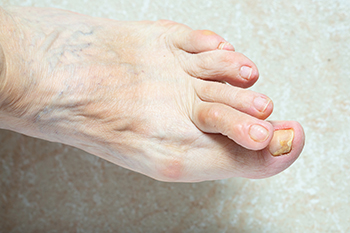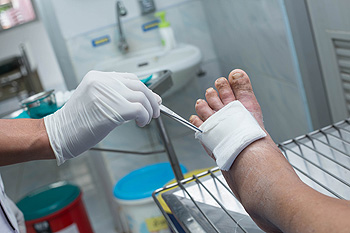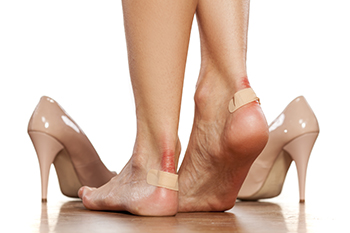
Ingrown toenails occur when the nail grows into the skin of the toe, causing irritation, inflammation, and sometimes infection. Home remedies may provide temporary relief from an ingrown toenail, but if pain persists or signs of infection develop, seeking attention from a podiatrist is important. In such cases, prescription medication and surgical intervention may be necessary. Nail avulsion is a minor procedure that involves removing the ingrown portion of the nail, or the entire nail plate, under local anesthesia. Partial nail avulsion allows for regrowth within months, while complete nail avulsion is less common and results in permanent removal. For recurrent cases of ingrown toenails, a matrixectomy may be recommended. This involves removing the nail root to prevent future ingrowth. Various techniques, including chemical, electrosurgical, or surgical methods, are employed based on individual needs. When an infection develops, a podiatrist will prescribe oral antibiotics to clear the bacteria and prevent complications. If you have persistent pain or redness due to an ingrown toenail, it is suggested that you schedule an appointment with a podiatrist for an exam and treatment options.
Ingrown toenails can become painful if they are not treated properly. For more information about ingrown toenails, contact Dr. Kendall Blackwell of InStride Wilson Podiatry Associates. Our doctor can provide the care you need to keep you pain-free and on your feet.
Ingrown Toenails
Ingrown toenails occur when a toenail grows sideways into the bed of the nail, causing pain, swelling, and possibly infection.
Causes
Prevention
Because ingrown toenails are not something found outside of shoe-wearing cultures, going barefoot as often as possible will decrease the likeliness of developing ingrown toenails. Wearing proper fitting shoes and using proper cutting techniques will also help decrease your risk of developing ingrown toenails.
Treatment
Ingrown toenails are a very treatable foot condition. In minor cases, soaking the affected area in salt or antibacterial soaps will not only help with the ingrown nail itself, but also help prevent any infections from occurring. In more severe cases, surgery is an option. In either case, speaking to your podiatrist about this condition will help you get a better understanding of specific treatment options that are right for you.
If you have any questions please feel free to contact our office located in Wilson, NC . We offer the newest diagnostic and treatment technologies for all your foot and ankle needs.

Overlapping toes, a condition where one toe rests on top of another, affects people of all ages, from newborns to adults. Causes include heredity, tight-fitting shoes, arthritis, and biomechanical issues. Underlying foot conditions, like bunions, flat feet, hammer toes, or high arches, can also contribute to developing overlapping toes. In newborns, this condition may result from heredity or the positioning of the baby in the womb. Gentle measures such as taping the toes or using toe spacers are effective for newborns, while adults can benefit from conservative methods like wearing properly fitting shoes and maintaining a healthy weight. If conservative treatments fail, surgery may be necessary, especially for severe cases or when a bunion is involved. Early intervention is key to preventing long-term complications. For help in managing problems related to overlapping toes, it is suggested that you schedule an appointment with a podiatrist for an accurate diagnosis and treatment options.
Toe pain can disrupt your daily activities. If you have any concerns, contact Dr. Kendall Blackwell of InStride Wilson Podiatry Associates. Our doctor can provide the care you need to keep you pain-free and on your feet.
What Causes Toe Pain?
Most severe toe pain is caused due to a sports injury, trauma from dropping something heavy on the toe, or bumping into something rigid. Other problems can develop over time for various reasons.
Toe pain can be caused by one or more ailments. The most common include:
When to See a Podiatrist
Diagnosis
In many cases the cause of toe pain is obvious, but in others, a podiatrist may want to use more advanced methods to determine the problem. These can range from simple visual inspections and sensation tests to X-rays and MRI scans. Prior medical history, family medical history, and any recent physical traumatic events will all be taken into consideration for a proper diagnosis.
Treatment
Treatments for toe pain and injuries vary and may include shoe inserts, padding, taping, medicines, injections, and in some cases, surgery. If you believe that you have broken a toe, please see a podiatrist as soon as possible.
If you have any questions please feel free to contact our office located in Wilson, NC . We offer the newest diagnostic tools and technology to treat your foot and ankle needs.

Foot drop is a condition characterized by the inability to lift or move the foot and toes. It is characterized by the failure to clear the ground when you take a step, forcing the need to have a marching gait when walking. Foot drop typically results from nerve injury, such as sports injuries, keeping the legs in one position for a long time, or peripheral neuropathy. Certain surgeries, including hip or knee replacements, also may increase the risk of foot drop. Treatment approaches vary, depending on the underlying cause and the duration of the condition. Exercises to strengthen and stretch the muscles of the leg and foot can help to improve mobility. Additionally, braces, splints, or custom orthotic shoe inserts can provide support and maintain proper foot alignment. In some cases, electrical nerve stimulation devices may be employed to aid nerve function. Surgical interventions, such as joint fusion or nerve repair, may be considered for those with permanent impairment. For help with managing foot drop, it is suggested that you schedule an appointment with a podiatrist for a full examination and an accurate diagnosis to determine what the proper treatment is for you.
If you have any concerns about your feet, contact Dr. Kendall Blackwell from InStride Wilson Podiatry Associates. Our doctor can provide the care you need to keep you pain-free and on your feet.
Biomechanics in Podiatry
Podiatric biomechanics is a particular sector of specialty podiatry with licensed practitioners who are trained to diagnose and treat conditions affecting the foot, ankle and lower leg. Biomechanics deals with the forces that act against the body, causing an interference with the biological structures. It focuses on the movement of the ankle, the foot and the forces that interact with them.
A History of Biomechanics
Modern technological improvements are based on past theories and therapeutic processes that provide a better understanding of podiatric concepts for biomechanics. Computers can provide accurate information about the forces and patterns of the feet and lower legs.
Understanding biomechanics of the feet can help improve and eliminate pain, stopping further stress to the foot.
If you have any questions please feel free to contact our office located in Wilson, NC . We offer the newest diagnostic and treatment technologies for all your foot and ankle needs.

Diabetes can lead to a variety of foot ulcers, which are wounds and sores that will not heal in a normal time frame. Ischemic ulcers are typically found on the toes and lateral foot areas. They are a result of underlying blood flow problems. Neuroischemic ulcers arise from a combination of diabetic neuropathy and peripheral artery disease, and tend to form at the metatarsal heads. These ulcers present a complex challenge because both damaged nerves and blood vessels are involved. Neuropathic ulcers, a common complication of diabetes, usually begin as callous formations on the bottom of the foot before progressing to ulceration. Patients with severe peripheral neuropathy may exhibit altered gait, skin changes, and reduced sensation, all of which increase the risk of ulcer development. The importance of regular foot exams and proactive foot care in individuals with diabetes cannot be overstated. If you or someone you know is living with diabetes, it is suggested that you schedule an appointment with a podiatrist at the first sign of ulcers on the feet.
Diabetic foot care is important in preventing foot ailments such as ulcers. If you are suffering from diabetes or have any other concerns about your feet, contact Dr. Kendall Blackwell from InStride Wilson Podiatry Associates. Our doctor can provide the care you need to keep you pain-free and on your feet.
Diabetic Foot Care
Diabetes affects millions of people every year. The condition can damage blood vessels in many parts of the body, especially the feet. Because of this, taking care of your feet is essential if you have diabetes, and having a podiatrist help monitor your foot health is highly recommended.
The Importance of Caring for Your Feet
Patients with diabetes should have their doctor monitor their blood levels, as blood sugar levels play such a huge role in diabetic care. Monitoring these levels on a regular basis is highly advised.
It is always best to inform your healthcare professional of any concerns you may have regarding your feet, especially for diabetic patients. Early treatment and routine foot examinations are keys to maintaining proper health, especially because severe complications can arise if proper treatment is not applied.
If you have any questions please feel free to contact our office located in Wilson, NC . We offer the newest diagnostic and treatment technologies for all your foot and ankle needs.

Blisters are small fluid-filled pockets that commonly form on the skin and can be particularly bothersome when they develop on the feet. Whether caused by friction from wearing ill-fitting shoes, prolonged walking, running, or heat, blisters can cause discomfort and interfere with daily activities. While most blisters on the feet heal naturally within a week, it is essential to avoid popping them yourself, as this can increase the risk of infection and prolong recovery time. Instead, gently cover the blister with a dry, sterile dressing to help protect it as it heals. If there are signs of infection, such as redness, swelling, or pus, seeking prompt medical attention from a podiatrist is suggested. Podiatrists may prescribe antibiotics for infected blisters or perform procedures like blister drainage under sterile conditions for larger or more painful blisters. If you experience persistent or recurrent blisters on your feet, it is suggested that you schedule an appointment with a podiatrist to ensure safe and effective treatment as well as prevention strategies.
Blisters may appear as a single bubble or in a cluster. They can cause a lot of pain and may be filled with pus, blood, or watery serum. If your feet are hurting, contact Dr. Kendall Blackwell of InStride Wilson Podiatry Associates. Our doctor can provide the care you need to keep you pain-free and on your feet.
Foot Blisters
Foot blisters are often the result of friction. This happens due to the constant rubbing from shoes, which can lead to pain.
What Are Foot Blisters?
A foot blister is a small fluid-filled pocket that forms on the upper-most layer of the skin. Blisters are filled with clear fluid and can lead to blood drainage or pus if the area becomes infected.
Symptoms
(Blister symptoms may vary depending on what is causing them)
Prevention & Treatment
In order to prevent blisters, you should be sure to wear comfortable shoes with socks that cushion your feet and absorb sweat. Breaking a blister open may increase your chances of developing an infection. However, if your blister breaks, you should wash the area with soap and water immediately and then apply a bandage to the affected area. If your blisters cause severe pain it is important that you call your podiatrist right away.
If you have any questions, please feel free to contact our office located in Wilson, NC . We offer the newest diagnostic and treatment technologies for all your foot care needs.